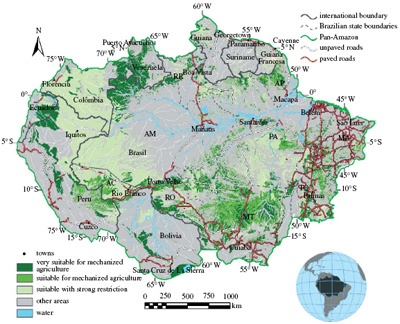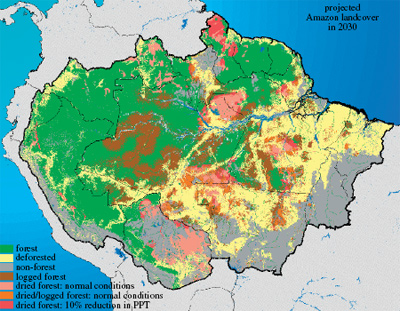More than half the Amazon will be lost within 20 years
Half the Amazon rainforest will be lost within 20 years
Rhett Butler, mongabay.com
February 27, 2008
|
|
More than half the Amazon rainforest will be damaged or destroyed within 20 years if deforestation, forest fires, and climate trends continue apace, warns a study published in Philosophical Transactions of the Royal Society B.
Reviewing recent trends in economic, ecological and climatic processes in Amazonia, Daniel Nepstad and colleagues forecast that 55 percent of Amazon forests will be “cleared, logged, damaged by drought, or burned” in the next 20 years. The damage will release 15-26 billion tons of carbon into the atmosphere, adding to a feedback cycle that will worsen both warming and forest degradation in the region.
While the projections are bleak, the authors are hopeful that emerging trends could reduce the likelihood of a near-term die-back. These include the growing concern in commodity markets on the environmental performance of ranchers and farmers; greater investment in fire control mechanisms among owners of fire-sensitive investments; emergence of a carbon market for forest-based offsets; and the establishment of protected areas in regions where development is fast-expanding.
Trends driving the Amazon towards a near-term die-back
Macroeconomic trends are an increasingly important driver of deforestation in the Amazon. The authors cite several developments that make converting Amazon forest for agricultural production more attractive, including the eradification of foot-and-mouth disease from large swathes of the Amazon, opening foreign markets for Brazilian beef exports; rising international demand for agro-industrial commodities, triggering land scarcity in traditional growing regions like Europe and the United States; surging interest in biofuels, fed by record high oil prices; and agricultural innovation that has produced crops suitable for cultivation in the Amazon’s climate. The authors note that American subsidies for corn ethanol production and Chinese meat consumption are indirectly contributing to Amazon deforestation and warn that though little oil palm is presently cultivated in the region, much of Amazonia is suitable for the plant, which is one of the world’s highest yielding biodiesel crops.
 Soil suitability map for mechanized agriculture in the Pan-Amazon region. Restrictions include slope (more than 2%), inundation risk and poor soil (ultisols, hydromorphic soils, sands and lithosols). Map from Nepstad et al (2008). |
At the same time that global demand for agricultural commodities produced in the Amazon is growing, the region is increasingly affected by drought (linked to climate change), fragmentation (tied to development) and forest fires (corresponding to both climate change and development) — all of which interact with one another to create positive feedback effects.
“Positive feedbacks among drought, forest fire and economic activities hold the potential to degrade large areas of Amazon forest over the coming years,” write the authors. “Land-use activities of the Amazon contribute to forest susceptibility to fire by providing ignition sources, by fragmenting the forest, and by thinning the forest through logging.
“Fires set to burn felled forests in preparation for crops or pasture, or to improve pasture forage, frequently escape beyond their intended boundaries into neighbouring forests,” they continue. “Forest fire can therefore increase susceptibility to further burning in a positive feedback by killing trees, opening the canopy and increasing solar penetration to the forest floor.”
Increasing frequency of drought as a result of warmer temperatures in the tropical Atlantic are also having an effect on the vulnerability of the Amazon to fire. Climate models suggest that as temperatures continue to climb, incidence and severity of drought in the eastern and southern Amazon will also increase. These regions are the areas that are seeing the most pressure from development. Further, some research suggests that deforestation itself — through the loss of transpiration — can trigger a decline in rainfall.
2030 forecast for the Amazon
Analyzing the interacting trends, the authors lay out a scenario where more than half the Amazon could be doomed by 2030.
 A map of Amazonia 2030, showing drought-damaged, logged and cleared forests assuming the last 10 years of climate are repeated in the future. See text for further details. PPT, precipitation. Map from Nepstad et al (2008). |
“The economic, ecological and climatic systems of the Amazon may be interacting to move the forests of this region towards a near-term tipping point,” they write. “In this scenario, the growing profitability of deforestation-dependent agriculture and cattle ranching provides an expanding frontier of forest fragmentation and ignition sources that inhibits rainfall as forests are replaced by fields and pastures and as fires fill the late dry season atmosphere with aerosols.”
“Forests damaged by drought, logging, fragmentation and previous fire burn repeatedly as tall canopy tree species are gradually replaced by coppicing trees, grasses and other high-biomass plants. These local and regional processes are exacerbated when sea surface anomalies and extreme weather events cause severe drought episodes and the burning of vast forested landscapes. Global warming reinforces these trends by elevating air temperatures, increasing dry season severity and increasing the frequency of extreme weather events.”
Based on these trends, Nepstad and colleagues forecast that 31 percent of the Amazon rainforest will be deforested and 24 percent will be damaged by drought or logging by the year 2030. They say a 10 percent drop in rainfall will result in drought damage to an additional 4 percent of the forests. The impacts from such degradation and deforestation will result in emissions of 15-26 Pg of carbon in less than three decades “without invoking the influence of global warming.” Worryingly, the authors note this scenario is a conservative one — forest loss and emissions could be far worse.
Avoiding the Amazon tipping point
Still Nepstad and colleagues are hopeful that such a tipping point can be avoided. They say landowners in the Amazon — especially those with fire sensitive investments like orchards, intensive-cattle operations, and managed timber harvesting — are increasingly aware of damage wrought by burning and are avoiding the use of fire as a land management tool, reducing the incidence of fires escaping into neighboring forest areas. Soy and beef producers are also responding to new emphasis on environmental performance from commodity buyers — soy growers in Mato Grosso are adhering to a moratorium on clearing of rainforest for soy production, while cattle ranchers are forming their own certification system for environmental standards. The Brazilian government has recently entered the fray by cracking down on illicit commodity production in the Amazon, sending in troops and implementing fines and threatening credit access to landowners for buying or trading soy, beef, and other products produced on illegally deforested lands.
Nepstad and colleagues say that intensification of cattle production — boosting head per hectare by a factor of 8 in some areas — is reducing the need to clear forest land for pasture. Finally the authors are optimistic that newly established protected areas can serve as a bulkhead against deforestation in especially vulnerable regions. They say carbon offsets under the REDD mechanism agreed to in principle at the December U.N. climate talks in Bali, Indonesia, can help finance forest conservation efforts as well as deliver benefits to rural people and indigenous groups.
Daniel C. Nepstad, Claudia M. Stickler, Britaldo Soares- Filho and Frank Merry (2008). Interactions among Amazon land use, forests and climate: prospects for a near-term forest tipping point [FREE OPEN ACCESS]. Phil. Trans. R. Soc. B, DOI: 10.1098/rstb.2007.0026
Related articles
Globalization could save the Amazon rainforest
The Amazon basin is home to the world’s largest rainforest, an ecosystem that supports perhaps 30 percent of the world’s terrestrial species, stores vast amounts of carbon, and exerts considerable influence on global weather patterns and climate. Few would dispute that it is one of the planet’s most important landscapes. Despite its scale — the basin covers 40 percent of South America — the Amazon is also one of the fastest changing ecosystems, largely as a result of human activities, including deforestation, forest fires, and, increasingly, climate change. Few people understand these impacts better than Dr. Daniel Nepstad, one of the world’s foremost experts on the Amazon rainforest. Now head of the Woods Hole Research Center’s Amazon program in Belém, Brazil, Nepstad has spent more than 23 years in the Amazon, studying subjects ranging from forest fires and forest management policy to sustainable development. Nepstad says the Amazon is presently at a point unlike any he’s ever seen, one where there are unparalleled risks and opportunities. While he’s hopeful about some of the trends, he knows the Amazon faces difficult and immediate challenges.
How much would it cost to end Amazon deforestation?
With Brazil last week announcing a significant jump in Amazon deforestation during the second half of 2007, the question emerges, how much would it cost to end the destruction of Earth’s largest rainforest? According to estimates by the Woods Hole Research Institute (WHRC), reducing deforestation in the Brazilian Amazon to nearly zero within a decade would cost $100 million to $600 million per year under a program involving carbon credits for forest conservation (REDD).
55% of the Amazon may be lost by 2030
Cattle ranching, industrial soy farming, and logging are three of the leading drivers of deforestation in the Brazilian Amazon. As commodity prices continue to rise, driven by surging demand for biofuels and grain for meat production, the economic incentives for developing the Amazon increase. Already the largest exporter of beef and the second largest producer of soy — with the largest expanse of “undeveloped” but arable land of any country — Brazil is well on its way to rivaling the U.S. as the world’s agricultural superpower. The trend towards turning the Amazon into a giant breadbasket seems unstoppable.
Global warming accelerates destruction of the Amazon
Deforestation and climate change could damage or destroy as much as 60 percent of the Amazon rainforest by 2030, according to a new report from environmental group WWF.
Can cattle ranchers and soy farmers save the Amazon rainforest?
John Cain Carter believes the only way to save the Amazon is through the market. Carter is a Texas rancher who moved to the heart of the Amazon 11 years ago with his Brazilian wife, Kika, and founded what is perhaps the most innovative organization working in the Amazon, Aliança da Terra. Carter says that by giving producers incentives to reduce their impact on the forest, the market can succeed where conservation efforts have failed.
U.S. ethanol may drive Amazon deforestation
Ethanol production in the United States may be contributing to deforestation in the Brazilian rainforest said a leading expert on the Amazon. Dr. Daniel Nepstad of the Woods Hole Research Center said the growing demand for corn ethanol means that more corn and less soy is being planted in the United States. Brazil, the world’s largest producer of soybeans, is more than making up for shortfall, by clearing new land for soy cultivation. While only a fraction of this cultivation currently occurs in the Amazon rainforest, production in neighboring areas like the cerrado grassland helps drive deforestation by displacing small farmers and cattle producers, who then clear rainforest land for subsistence agriculture and pasture.